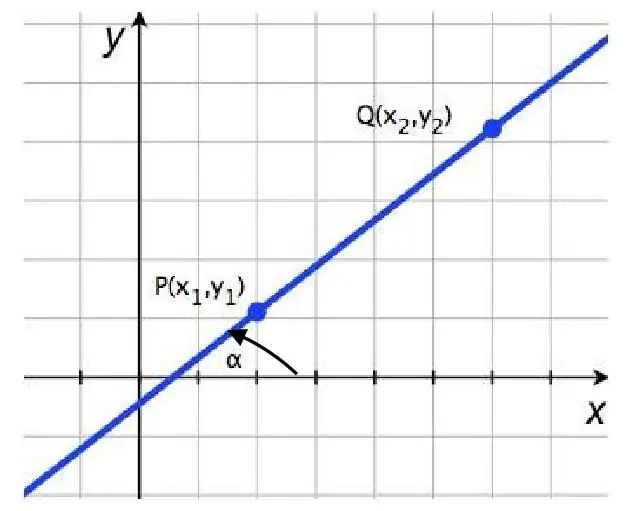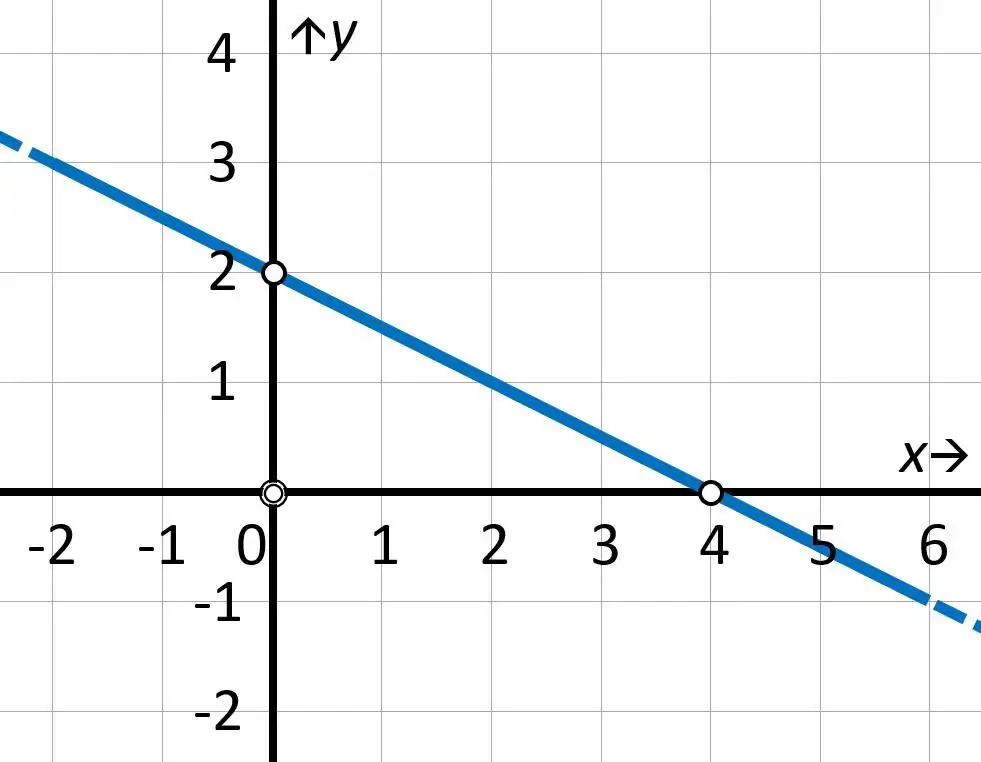The straight line is the main geometric object on the plane and in three-dimensional space. It is from straight lines that many figures are built, for example: a parallelogram, a triangle, a prism, a pyramid, and so on. Consider in the article various ways of setting the equations of lines.
Definition of a straight line and types of equations to describe it

Each student has a good idea of what geometric object they are talking about. A straight line can be represented as a collection of points, and if we connect each of them in turn with all the others, then we get a set of parallel vectors. In other words, it is possible to get to each point of the line from one of its fixed points, transferring it to some unit vector multiplied by a real number. This definition of a straight line is used to define a vector equality for its mathematical description both in the plane and in three-dimensional space.
A straight line can be mathematically represented by the following types of equations:
- general;
- vector;
- parametric;
- in segments;
- symmetrical (canonical).
Next, we will consider all the named types and show how to work with them using examples of solving problems.
Vector and parametric description of a straight line

Let's start by defining a straight line through a known vector. Assume that there is a fixed point in space M(x0; y0; z0). It is known that the straight line passes through it and is directed along the vector segment v¯(a; b; c). How to find an arbitrary point of the line from these data? The answer to this question will give the following equality:
(x; y; z)=(x0; y0; z0) + λ(a; b; c)
Where λ is an arbitrary number.
A similar expression can be written for the two-dimensional case, where the coordinates of vectors and points are represented by a set of two numbers:
(x; y)=(x0; y0) + λ(a; b)
The written equations are called vector equations, and the directed segment v¯ itself is the directing vector for the straight line.
From the written expressions, the corresponding parametric equations are obtained simply, it is enough to rewrite them explicitly. For example, for the case in space, we get the following equation:
x=x0+ λa;
y=y0+ λb;
z=z0+ λc
It is convenient to work with parametric equations if you need to analyze the behavioreach coordinate. Note that although the parameter λ can take arbitrary values, it must be the same in all three equalities.
General equation

Another way to define a straight line, which is often used to work with the considered geometric object, is to use a general equation. For the two-dimensional case, it looks like:
Ax + By + C=0
Here capital Latin letters represent specific numerical values. The convenience of this equality in solving problems lies in the fact that it explicitly contains a vector that is perpendicular to a straight line. If we denote it by n¯, then we can write:
n¯=[A; B]
In addition, the expression is convenient to use to determine the distance from a straight line to some point P(x1; y1). The formula for distance d is:
d=|Ax1+ By1+ C| / √(A2+ B2)
It is easy to show that if we explicitly express the variable y from the general equation, we get the following well-known form of writing a straight line:
y=kx + b
Where k and b are uniquely determined by the numbers A, B, C.
The equation in segments and canonical

The equation in segments is easiest to get from the general view. We'll show you how to do it.
Suppose we have the following line:
Ax + By + C=0
Move the free term to the right side of the equality, then divide the whole equation by it, we get:
Ax + By=-C;
x / (-C / A) + y / (-C / B)=1;
x / q + y / p=1, where q=-C / A, p=-C / B
We got the so-called equation in segments. It got its name due to the fact that the denominator by which each variable is divided shows the value of the coordinate of the intersection of the line with the corresponding axis. It is convenient to use this fact to depict a straight line in a coordinate system, as well as to analyze its relative position in relation to other geometric objects (straight lines, points).
Now let's move on to obtaining the canonical equation. This is easier to do if we consider the parametric option. For the case on the plane we have:
x=x0+ λa;
y=y0+ λb
We express the parameter λ in each equality, then we equate them, we get:
λ=(x - x0) / a;
λ=(y - y0) / b;
(x - x0) / a=(y - y0) / b
This is the desired equation written in symmetrical form. Just like a vector expression, it explicitly contains the coordinates of the direction vector and the coordinates of one of the points that belongs to the line.
It can be seen that in this paragraph we have given equations for the two-dimensional case. Similarly, you can write the equation of a straight line in space. It should be noted here that if the canonical formrecords and expression in segments will have the same form, then the general equation in space for a straight line is represented by a system of two equations for intersecting planes.
The problem of constructing the equation of a straight line
From geometry, every student knows that through two points you can draw a single line. Assume that the following points are given in the coordinate plane:
M1(1; 2);
M2(-1; 3)
It is necessary to find the equation of the line to which both points belong, in segments, in vector, canonical and general form.
Let's get the vector equation first. To do this, define for the direct direction vector M1M2¯:
M1M2¯=(-1; 3) - (1; 2)=(-2; 1)
Now you can create a vector equation by taking one of the two points specified in the problem statement, for example, M2:
(x; y)=(-1; 3) + λ(-2; 1)
To get the canonical equation, it is enough to transform the found equality into a parametric form and exclude the parameter λ. We have:
x=-1 - 2λ, therefore λ=x + 1 / (-2);
y=3 + λ, then we get λ=y - 3;
x + 1 / (-2)=(y - 3) / 1
The remaining two equations (general and in segments) can be found from the canonical one by transforming it as follows:
x + 1=-2y + 6;
general equation: x + 2y - 5=0;
in segments equation: x / 5 + y / 2, 5=1
The resulting equations show that the vector (1; 2) must be perpendicular to the line. Indeed, if you find its scalar product with the direction vector, then it will be equal to zero. The line segment equation says that the line intersects the x-axis at (5; 0) and the y-axis at (2, 5; 0).
The problem of determining the point of intersection of lines

Two straight lines are given on the plane by the following equations:
2x + y -1=0;
(x; y)=(0; -1) + λ(-1; 3)
It is necessary to determine the coordinates of the point where these lines intersect.
There are two ways to solve the problem:
- Transform the vector equation into a general form, then solve the system of two linear equations.
- Do not perform any transformations, but simply substitute the coordinate of the intersection point, expressed through the parameter λ, into the first equation. Then find the parameter value.
Let's do the second way. We have:
x=-λ;
y=-1 + 3λ;
2(-λ) + (-1) + 3λ - 1=0;
λ=2
Substitute the resulting number into the vector equation:
(x; y)=(0; -1) + 2(-1; 3)=(-2; 5)
Thus, the only point that belongs to both lines is the point with coordinates (-2; 5). The lines intersect in it.






